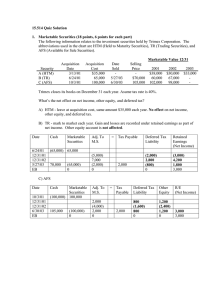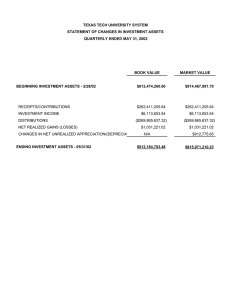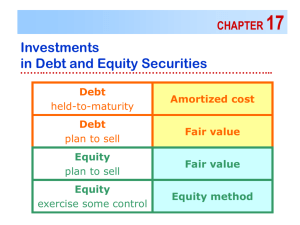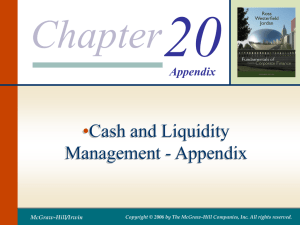Document 13615409
advertisement
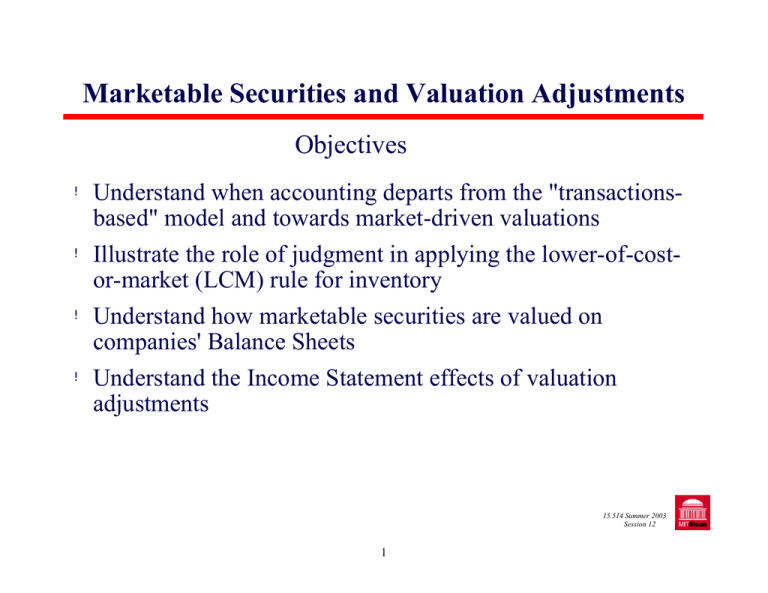
Marketable Securities and Valuation Adjustments Objectives ! ! ! ! Understand when accounting departs from the "transactions­ based" model and towards market-driven valuations Illustrate the role of judgment in applying the lower-of-cost- or-market (LCM) rule for inventory Understand how marketable securities are valued on companies' Balance Sheets Understand the Income Statement effects of valuation adjustments 15.514 Summer 2003 Session 12 1 Should changes in market value be recognized? ! Accounts receivable < Estimates of uncollectibles < Changes in credit risk ! Inventory < Purchase/production cost < Changes in input prices, obsolescence ! Fixed Assets < Acquisition cost (historical basis) < Obsolescence Reliability vs. Relevance 15.514 Summer 2003 Session 12 2 Lower of cost or market rule for Inventory < When Market Value of Inventory < Capitalized Cost < Loss on inventory writedown = Capitalized cost - Market Value, added to Cost of Goods Sold < Market value = minimum of replacement cost and selling price < Once inventory written down in the balance sheet, it cannot be “written up” in subsequent periods < Issues < Susceptibility to writedowns of LIFO vs. FIFO < “Hidden reserves” and income smoothing 15.514 Summer 2003 Session 12 3 Valuation Adjustments: Royal Precision Royal Precision, Inc. and Subsidiaries Consolidated Statements of Operations Year ended May 31 (000) 2002 2001 2000 Net sales: Golf club shafts $19,833 $26,070 $25,559 Golf club grips 3,729 3,927 4,540 23,562 29,997 30,099 Cost of sales: Golf club shafts 17,430 18,927 17,562 Golf club grips 3,058 3,056 3,137 20,488 21,983 20,699 3,074 8,014 9,400 Gross profit included in here Net (loss) income $(11,730) $(584) $870 The operating loss for the fiscal year 2002 included the following nonrecurring items: a $1.4 million charge to adjust inventory to its expected net realizable value… 15.514 Summer 2003 Session 12 4 What are Marketable Securities? ! Marketable securities < Corporate and government bonds, treasuries < Common stock < Derivative instruments: options, swaps, etc. ! Question < Should changes in market value of Marketable Securities be recognized (i.e., recorded on the I/S and B/S) 15.514 Summer 2003 Session 12 5 SFAS 115 ! Mark-to-market accounting: gains and losses treated similarly ! New classifications < < < ! Trading securities (debt and equity) Available for sale (debt and equity) Held-to-maturity (debt only) Controversy: where should changes in market value be reported? 15.514 Summer 2003 Session 12 6 Marketable Securities ! ! ! Trading securities (debt and equity) < Acquired for short-term profit potential < Changes in market value reported in the income statement, investment marked to market in the balance sheet < Purchases and disposals reported in operating section of SCF Held to maturity (debt only) < Acquired with ability and intent to hold to maturity < No changes in market value reported in the income statement, thus investment carried at historical cost in the balance sheet < Interest income reported in operating section of SCF Available for sale (debt and equity) < Securities not classified as either of above < Changes in market value reported in “Other Equity” (net of taxes), instead of the income statement! < Purchases and disposals reported in investing section of SCF 15.514 Summer 2003 Session 12 7 Intel SCF 2002 Net income . . . . . . . . . . . . . . . . . . . . . . . . . . . . . . . . . . . . . . . . . . . . . . . . . . . . . . Adjustments to reconcile net income to net cash provided by operating activities: ...... (Gains) losses on equity securities, net . . . . . . . . . . . . . . . . . . . . . . . . . . . . . . . . . . (Gain) loss on investment in Convera . . . . . . . . . . . . . . . . . . . . . . . . . . . . . . . . . . . Changes in assets and liabilities: Trading assets . . . . . . . . . . . . . . . . . . . . . . . . . . . . . . . . . . . . . . . . . . . . . . . . ..... Total adjustments . . . . . . . . . . . . . . . . . . . . . . . . . . . . . . . . . . . . . . . . . . . . . Net cash provided by operating activities . . . . . . . . . . . . . . . . . . . . . . . . . . . . . . . . . . Cash flows provided by (used for) investing activities: Additions to property, plant and equipment . . . . . . . . . . . . . . . . . . . . . . . . . . . . . . Acquisitions, net of cash acquired . . . . . . . . . . . . . . . . . . . . . . . . . . . . . . . . . . . . . Purchases of available-for-sale investments . . . . . . . . . . . . . . . . . . . . . . . . . . . . . . . Maturities and sales of available-for-sale investments . . . . . . . . . . . . . . . . . . . . . . . . Other investing activities . . . . . . . . . . . . . . . . . . . . . . . . . . . . . . . . . . . . . . . . . . . Net cash used for investing activities . . . . . . . . . . . . . . . . . . . . . . . . . . . . . . . . . . . . . 2002 2001 2000 3,117 1,291 10,535 372 — 466 196 (3,759) (117) (444) 898 38 6,012 9,129 7,498 8,789 2,292 12,827 (4,703) (57) (6,309) 5,634 (330) (5,765) (7,309) (883) (7,141) 15,398 (395) (330) (6,674) (2,317) (17,188) 17,124 (980) (10,035) 15.514 Summer 2003 Session 12 8 “Adjunct” account An Illustration: Acquisition and Dividends (2002) On Jan. 1, 2002, Ace acquired 500 common shares of security MITCo for $25/share. C MS +MS adj DTL OE RE Trading: AFS: On Nov. 30, 2002, Ace received $625 in dividends ($1.25/share of MITCo) C MS +MS adj DTL OE RE Trading: AFS: 15.514 Summer 2003 Session 12 9 Unrealized Gains and Losses (2002) On Dec. 31, 2002, MITCo is trading at $30/share. Ace elected to keep the shares, and has a tax rate of 30%. Trading: BB: C MS 12,500 +MS adj DTL OE RE C MS 12,500 +MS adj DTL OE RE EB: AFS: BB: EB: 15.514 Summer 2003 Session 12 10 Unrealized Gains and Losses (2003) On Dec. 31, 2003, MITCo is trading at $27/share. Ace elected to keep the shares. Trading: BB: C MS 12,500 +MS adj 2,500 DTL 750 OE RE C MS 12,500 +MS adj 2,500 DTL 750 OE 1,750 RE EB: AFS: BB: EB: 15.514 Summer 2003 Session 12 11 Realized Gains and Losses (2004) On Feb. 14, 2004, Ace sold all of its investment in MITCo, then trading at $36/share. Trading: BB: C MS 12,500 +MS adj 1,000 DTL 300 OE RE C MS 12,500 +MS adj 1,000 DTL 300 OE 700 RE EB: AFS: BB: EB: 15.514 Summer 2003 Session 12 12 Marketable Securities: Pre-Tax Income patterns Trading Available for Sale 5,500 5,500 4,500 4,500 2,500 2,500 02 -1500 03 04 02 03 04 -1500 15.514 Summer 2003 Session 12 13 Reclassifications of Marketable Securities < Trading to Available for sale < Gains or losses of the period recognized on reclassification date < Subsequent market value changes reported in “Other Equity” < Available for sale to Trading < Cumulative gains or losses, including those of current period, recognized on reclassification date < Subsequent market value changes reported in the income statement 15.514 Summer 2003 Session 12 14 Marketable Securities Disclosure - Intel Availab le-for-Sale Investments Available-for-sale investments at December 28 , 2002: see Intel 2002 Annual Report, pp. 58. 19 Available-for-sale investments at December 29 , 2001: see Intel 2001 Annual Report, pp. 28. 50 Change = 19 - 50 = -31 decrease in MSadj 15.514 Summer 2003 Session 12 15 Intel’s Deferred Tax Liability Accounts Assets = Cash Oth Assets = BB1 Liabilities + inc tax pay. net def taxes 998 (13) Tax Expense2 Tax Payments3 Security Gains4 977 (475) 110 (1,087) (475) 37 13 Tax benefit of stock plans5 (270) Other (plug)6 (73) (14) 1,157 96 EB1 S. E. OE RE 24 270 1. From the Balance Sheet; Negative indicates net deferred tax asset The Income Statement reports 1,087 as the total tax expense. The components come from the tax footnote. Payable (542+143+292) + Deferred (91+19). 3. 475 cash payment from the SCF. 4. The 24 (43-19). is from the Statement of Stockholder’s Equity and is net of tax With a tax rate of 35% the gross change is (37) and the deferred tax is (13). The available for sale component of the change in other asssets (-19/.65) which equals (29) approximates the value calculated from the footnote for AFS investment. 5. From the Statement of Stockholder’s Equity. Trust us on the offset to “Other Equity.” 15.514 Summer 2003 6. Session 12 Like it says, a plug. 2. 16 Data Source: Intel Corporation's Annual Report. Why does recognition of gains/losses matter? Former SEC Chairman Breeden, on mark-to-market (ca 1990): If you are in a volatile business, then your balance sheet and income statement should reflect that volatility. Furthermore, we have seen significant abuse of managed earnings. Too often companies buy securities with an intent to hold them as investments, and then miraculously, when they rise in value, the companies decide it's time to sell them. Meanwhile, their desire to hold those securities that are falling in value grows ever stronger. So companies report the gains and hide the losses. Former SEC Chairman Arthur Levitt, Jr (1997): it is unacceptable to allow American investors to remain in the dark about the consequences of a $23 trillion derivatives exposure. We support the independence of the FASB as they turn on the light. Federal Reserve Chairman Greenspan, on derivatives (ca 1997): Putting the unrealized gains and losses of open derivatives contracts onto companies’ income statements would introduce "artificial" volatility to their earnings and equity. Shareholders would become confused; management might forego sensible hedging strategies out of purely window dressing concerns. 15.514 Summer 2003 Session 12 17 A compromise (and “compromised’) GAAP? ! Recognize all unrealized gains/losses for “trading securities” in Net Income ! Mark “available for sale” securities to market value, but don’t report changes in the income statement. This reduces the “volatility” of the income statement. (Managers do not like volatility and have similarily complained about the volatility derivatives accounting could have -but that’s another issue) ! Ignore value changes for “held to maturity” category 15.514 Summer 2003 Session 12 18 FAS 130 (June 1997): Comprehensive Income < Addressed concerns many had of items bypassing the income statement. < Unrealized gains/losses of AFS securities are recorded directly to shareholders' equity as a component of "Other Comprehensive Income." < Do NOT include as part of net income. (do not pass GO; do not accrue $200) 15.514 Summer 2003 Session 12 19 Intel: Other comprehensive income For financial data on Intel's Components of Comprehensive Income at December 29, 2001 and December 28, 2002, see that portion of Intel Corporation's 2002 Annual Report, pp. 48. 15.514 Summer 2003 Session 12 20 Realized versus unrealized gains: 2000 For financial data, see "Consolidated Statements of Stockholders' Equity" and "Consolidated Statements of Income" portions of Intel Corporation's 2000 Annual Report, pp. 21 and 18, respectively. 15.514 Summer 2003 Session 12 21 Marketable Securities in other countries ! Canada: LCM for investments classified as current assets; historical cost for noncurrent assets, but recognize “permanent” declines in value ! Mexico: Carry marketable securities at net realizable value, report gains/losses in the income statement; LCM for other investments ! Japan: LCM for marketable securities ! Others: Typically either LCM or mark-to-market, exclusively 15.514 Summer 2003 Session 12 22 Summary: Marketable Securities and Valuation Adjustments ! Valuation adjustment necessary when changes in market values are objectively measurable ! Lower of cost or market applied to inventory valuation ! Mark-to-market accounting for marketable securities ! Disclosure vs. Recognition in mark-to-market accounting: < Not all gains and losses are reported in the income statement < Unrealized gains and losses are part of comprehensive income ! A compromise GAAP: a “compromised” GAAP, too? 15.514 Summer 2003 Session 12 23
